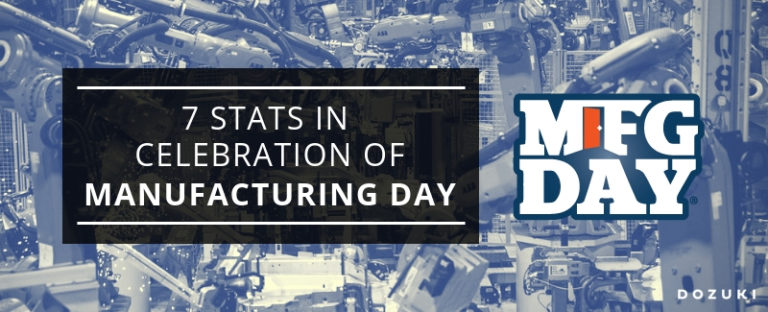
Industry News
3 min read
7 Stats in Celebration of Manufacturing Day

In the past, we put together a dream team of manufacturing icons and their contributions. In celebration of Manufacturing Day 2018, we’d like to share key statistics to highlight contributions manufacturing has made over history, and upcoming industry challenges.
Manufacturing Employment
Every manufacturing job creates 2.5 new jobs in goods and services
From another perspective, for every $1 invested in manufacturing, another $1.37 in additional value is created in other sectors. Because of this rippling effect, investing in the manufacturing sector is one the most effective ways to grow the economy overall.
Manufacturing is the fifth largest employment sector in the U.S.
Despite slower growth in recent decades, the industry remains a growing contributor to domestic employment.
Manufacturing Jobs Pay Higher than Average
Annual pay for manufacturers is 12.8% higher than the U.S. average
Manufacturers pay higher starting salaries and require constant skills development and growth. This means that skilled employees are valued more and manufacturing companies are willing to pay for top talent.
Powering Economic Growth
Production is predicted to grow at a rate of 2.8% from 2018 to 2021
This growth is unprecedented and is expected to outpace overall economic growth (2.3%) over the same period.
3.4 million manufacturing jobs will be created by 2025
Due to industry growth and a retiring workforce, hiring rates will be steadily increasing over the next 7 years.
The Skills Gap
By 2025, 2 million manufacturing jobs are expected to go unfilled
This presents a tremendous challenge and opportunity for companies to attract and train new employees. Outdated assumptions about the nature of manufacturing work has lead to public misconceptions. Fortunately, events like MFG Day and Industry 4.0 technologies are changing that.
94% of manufacturing executives cited internal employee training and development as the most effective way to close the skills gap
With large portions of the current workforce retiring, companies will need to capture tribal knowledge quickly and document training material efficiently.
Related Posts
View All Posts
Industry News
Dozuki Featured on CBS News at World Economic Forum
3 min read
Dozuki was featured on CBS News at the World Economic Forum in Davos. This segment highlights how digital transformation is no longer optional, but necessary for survival in...
Continue Reading
Industry News
Is the U.S. Headed for a Manufacturing Boom?
2 min read
While many industrial businesses are impacted by the COVID-19 pandemic, good news for U.S. manufacturers may be on the horizon. In the recent April industry report by...
Continue Reading
Industry News
The Four Disruptive Forces Reshaping Manufacturing
7 min read
Manufacturers are at an inflection point. Emerging technologies, shifting customer expectations, and rising workforce pressures are converging—and fast. The pace of change is...
Continue Reading



